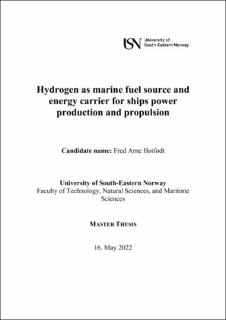| dc.description.abstract | At present, the shipping industry’s energy demands are covered satisfyingly with traditional fossil fuels. However, the global effort to prevent climate change has led the International Maritime Organization (IMO) to impose ambitious decarbonization goals and regulations to the shipping industry. Achieving carbon-free operations is today of concern for the entire shipping industry. One of the emerging and most promising options as fuel and energy carrier, are hydrogenous solutions.
This study reviews three hydrogenous solutions as fuel and energy carrier onboard ships: Liquefied hydrogen (LH2) in low temperature cryogenic tanks with pressure up to 12 bar, ammonia (NH3) in tanks with pressure up to 18 bar, and lastly, liquefied organic hydrogen carrier (LOHC) in tank at atmospheric pressure.
Firstly, the study is done through an informal pre-study which includes informal interview with experts on the field, and secondly with a formal academical Systematic Literature Review(SLR). The results of these two are combined and compared to elaborate on which of the three hydrogenous alternatives presents the most potential when considering feasibility, safety, and sustainability.
The goal of this thesis is to provide a practical summary of the existing operational and technical knowledge so that actors in the shipping industry can easier decide which hydrogenous solution they would want to move forward with in the future. This study shows that hydrogen loaded up into NH3 is the most feasible and sustainable large-scale present solution for ocean going vessels. LOHC might have a future for local trades. LH2 seems neither safe enough with present technology, nor feasible for a large global scale implementation.
However, without a sustainable blue or green energy source for production, the transition into hydrogenous solutions become counterproductive to its original purpose of reducing CO2emission footprint and air pollution. Sufficient capacity and availability of green or blue energy must emerge to satisfy the global transition. One solution for producing enough non carbon energy, can be contented by nuclear power.
The two parts of this study did not show any contradictory, but rather complimentary information. What the research work did show was that few big actors have published most of the articles on the subject, and that some countries are much more involved in this research than others. It is crucial for the success of the energetic energy transition of the shipping industry that research effort become amplified and diversified. | en_US |
